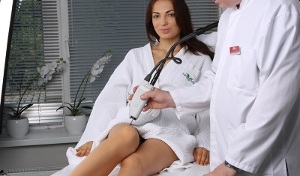How to remove leg veins without surgery if they are enlarged with varicose veins? Many people want to get rid of ugly enlarged leg veins, which are not only ugly, but also dangerous to health. But can you do without surgery or is there no other way?
How does the disease develop?

Is it possible to cure varicose veins without surgery? To answer this question, it is necessary to consider what happens to the vein during the development of the disease.
The pathology develops in several stages:
- vein valves weaken, stop interfering with reverse blood flow;
- valve insufficiency gradually increases and the vessel begins to stretch to accommodate a large amount of returned fluid;
- as the venous wall stretches, more and more blood is retained in the deformed part of the vessel and congestion occurs, which worsens blood flow;
- in the future, the process spreads to nearby parts of the vessel and causes malnutrition of nearby tissues.
But is vein removal always necessary? Are there ways to get rid of varicose veins without surgery?
When is conservative treatment possible?
In the early stages of the development of the disease, the operation to remove the vein from the legs is not performed; to restore the full functioning of the venous valve, it is enough to restore the tone of the vessel.
But conservative therapy should be comprehensive and include:
- change the patient's lifestyle;
- power correction;
- compression effect;
- medication intake.
Lifestyle change
Insufficient physical activity or, on the contrary, excessive physical effort, insufficient rest and bad habits: all this causes an alteration of the blood circulation in the leg.
Lifestyle changes help restore vascular tone. To do this, you need:
- Provide dosed physical activity. Hiking, swimming, yoga, or fitness without strength training are excellent ways to increase vascular tone and narrow the venous lumen. And if the clearance decreases, then the valve will adhere completely to the wall of the container, preventing filling. In the early stages of development, sports exercises are one of the main methods to cure varicose veins without surgery.
- Arrange a work and rest schedule. If it is not possible to avoid a long stay while working with your legs, then during the break you should sit with your legs slightly up, and during work do not stand still, but step on your legs, which will cause the muscles to contractof the calf. Regular contraction of the muscles will increase vascular tone.
- Stop smoking and drink only small amounts of alcohol. If the sick person continues to smoke and drink, they will soon have to undergo phlebectomy surgery.
Diet correction
When varicose veins are treated without surgery, what a person eats plays an important role.
Exclude from menu:
- hot spices;
- fatty and fried foods;
- carbonated drinks;
- baked goods.
You must limit the amount of candy. It is better to replace sweets or cakes with homemade jam, honey and nuts.

The menu should include a large amount of seafood:
- squid;
- mussels;
- seaweed;
- shrimp.
Shellfish contain copper, which has a tonic effect on venous tone.
In addition to the above products, it is recommended to eat more plant foods and drink natural juices and fruit drinks. It is allowed to eat liver and lean meats.
Compress action
This is bandaging and wearing elastic underwear (tights, leggings). Elastic underwear is put on lying down without getting out of bed in the morning and removed at night before going to bed, the same applies to bandaging. Compression therapy helps prevent further stretching of the vein wall and reduces the negative consequences of the disease.
It is also recommended to wear compression underwear in the postoperative period, this will help to shorten the rehabilitation and ensure the rapid restoration of full blood supply to the limb.
But compression therapy does not serve as a stand-alone method to help avoid surgery to remove veins in the legs. It only helps prevent the negative consequences associated with the development of impaired venous blood flow.
Medications
Patients are prescribed medications to increase venous tone.
Venotonics can be prescribed in tablets, ointments or injections, but their dose is selected individually, depending on the severity of the pathology.
In addition, symptomatic treatment is performed. For example, with a tendency to thrombosis, anticoagulants are prescribed, and with phlebitis, anti-inflammatory drugs.
But all treatment must be comprehensive. If the patient thinks about how to remove the veins in the legs without surgery, but at the same time does not stop smoking and eating spicy foods, he will be disappointed; this is impossible. Without changing your lifestyle and diet, you will soon need vein surgery in your leg.
If you cannot do without surgery

If conservative therapy has not been successful and the patient has frequent pain and cramps in the legs, trophic ulcers develop, or phlebitis occurs frequently, then an operation should be performed to reduce the consequences of the disease.
But vein surgery can also be performed with minimally invasive treatment methods:
- laser correction:
- sclerosing effect;
- laser ablation;
- radiofrequency ablation;
- ligation;
- minor phlebectomy.
Laser correction
It is carried out in the initial stage of the disease, when only small vessels are deformed and spider veins appear on the skin. Percutaneous exposure to a laser pulse contributes to the collapse of the walls of small crowns and the closure of the lumen. But only the initial stages of the disease can be cured with laser correction. For this, several sessions are sufficient. Rehabilitation is not required after laser surgery.
Sclerosing effect
A sclerosant, a special solution that causes a loss of elasticity of the vascular wall, is injected into the lumen of a deformed vein that cannot perform its function. This method can be used for both large and small boats. But with a large venous injury, although the blood circulation in the extremities will improve, the cosmetic defect may persist.
Laser ablation
A sterile catheter is inserted into the dilated section of the vein and an electrode is inserted through it. The action of the laser is carried out on the internal surface of the vessel, causing the collapse of its walls and the complete closure of the light. Blood flow begins to occur through the smaller vessels and the vein exposed to the laser radiation gradually becomes thinner and disappears.
The postoperative period with such an intervention can last up to a day, but the complete removal of cosmetic defects will occur only after a few months.
Radiofrequency ablation
The method is similar to the laser method, but uses radio frequency radiation. Radiofrequency ablation is performed on large vessels and the approximate duration of radiation exposure: from the groin to the knee or from the knee to the foot. The therapeutic effect is achieved in 2-3 sessions, but the complete disappearance of the deformed vein will occur in a few weeks.
Ligature
The imposition of a ligature (bandage) on both sides at the site of the great vessel allows it to be disconnected from the blood flow system, which will begin to bypass the smaller veins. The overlapping sites of the ligation fall off and grow together firmly. Ligation is performed on an outpatient basis under local anesthesia: small incisions are made in the skin and venous ligation is performed. Ligation is considered a good method to get rid of varicose veins when there are already negative consequences associated with impaired blood flow. "Shutting down" the pathologically deformed venous site from circulation helps reduce pain and edema.
Minor phlebectomy
This surgery is also performed on an outpatient basis under local anesthesia. The difference from ligation is that after ligation, the altered venous areas are removed and removed through small incisions in the skin. Compared to surgical phlebectomy (in which the vein is completely removed), this mini operation is considered less traumatic and requires almost no rehabilitation.
Although minimally invasive treatment methods are considered a surgical intervention due to the mechanical effect on the vessels, after surgery on the leg veins using the above methods, the negative consequences of the intervention for the patient are minimal andrehabilitation after the operation is carried out in a short time.
It is possible to remove varicose enlargement of the legs without surgery, but the success of the treatment depends not only on the chosen method, but also on the willingness of the patient to follow medical recommendations.























